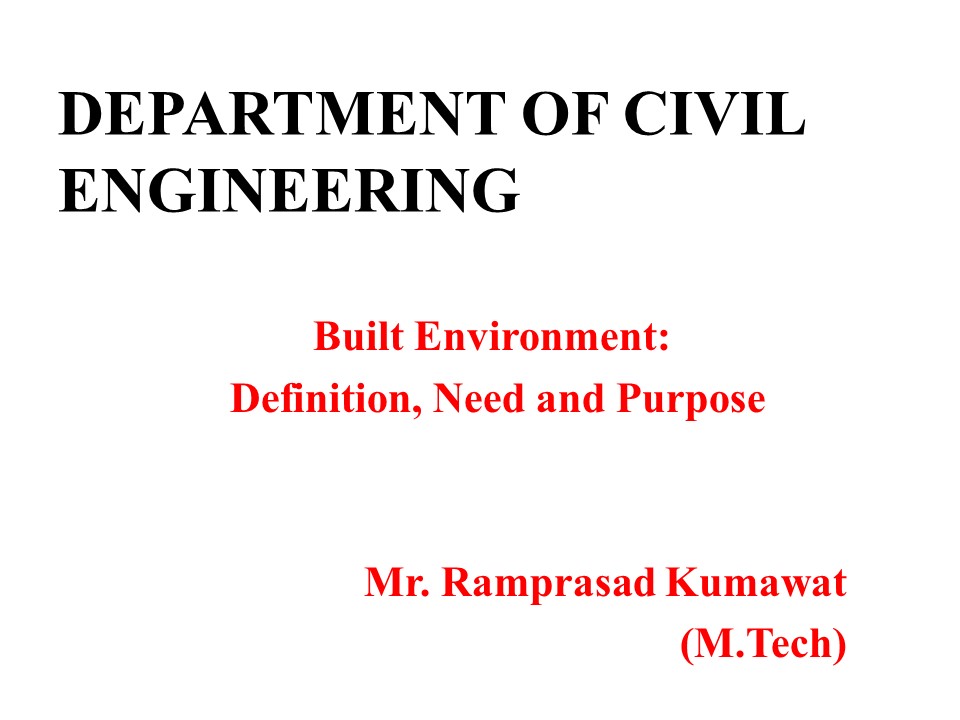Introduction of Built Environment - PowerPoint PPT Presentation
Title:
Introduction of Built Environment
Description:
Introduction of Built Environment – PowerPoint PPT presentation
Number of Views:1
Title: Introduction of Built Environment
1
DEPARTMENT OF CIVIL ENGINEERING
- Built Environment
- Definition, Need and Purpose
- Mr. Ramprasad Kumawat
- (M.Tech)
2
Built Environment
- Built Environment Definition, need and purpose
- Elements of Built Environment
- a) Homes, Offices and Commercial Buildings, Parks
and Recreation Centers (Civil Engineering is the
basis for developing the built-environment) - b) Transportation systems consisting of roads,
railway tracks, culverts, and Airport runways
3
- c) Water resources and water systems
- d) Infrastructure mainly consisting of buildings,
bridges, Tunnels, dams, canals, sewer systems - e) Ground support systems
4
Built Environment Definition, need and purpose
- It is everything human created, modified, or
constructed, human made, arranged, or maintained. - It is the creation of human minds and the result
of human purposes it is intended to serve human
needs, wants, and values.
5
- It is created to help us deal with, and to
protect us from, the overall environment, to
mediate or change this environment for our
comfort and well-being. - Each and all of the individual elements
contribute either positively or negatively to the
overall quality of environments both built and
natural and to human-environment relationships.
6
(No Transcript)
7
- The term built environment refers to the
human-made surroundings that provide the setting
for human activity, ranging in scale from
buildings and parks or green space to
neighborhoods and cities that can often include
their supporting infrastructure, such as water
supply or energy networks.
8
- The built environment is a material, spatial, and
cultural product of human labor that combines
physical elements and energy in forms for living,
working, and playing. - It has been defined as the human-made space in
which people live, work, and recreate on a
day-to-day basis
9
Human Needs
- To survive, all organisms must satisfy certain
basic needs. Humans are no exception. - The most basic set of needs are
physiologicalthose required for proper
functioning of the body and mind.
10
(No Transcript)
11
General types of Needs The Six Levels of Human Needs Ways the Needs are Manifested in the Built Environment
PHYSIOLOGICAL NEED 1) Subsistence Air, Water, Food, And Shelter, Economics and Technology
PHYSIOLOGICAL NEED 2) Reproduction Kinship, Marriage
PHYSIOLOGICAL NEED 3) Security and Bodily Protection Shelter, Territoriality Medical, Police, and Fire Protection, Weaponry, Law and Government
PSYCHOLOGICAL AND SOCIAL NEEDS 4) Protection from social Dysfunction of Insult Ethics , Sense of Community, territoriality Mental Health Service
PSYCHOLOGICAL AND SOCIAL NEEDS 5) Protection From Anxiety and Need of Belong The Arts , Religion Cosmology , Philosophy, Myth Magic Community Kinship Territoriality
PSYCHOLOGICAL AND SOCIAL NEEDS 6) Self Realization Freedom Responsibility Education, The Arts.
12
- Human needs can be physiological or social and
are related to security, respect, and
self-expression. - People want their built environment to be
aesthetically attractive and to be in an
accessible place with a well-developed
infrastructure, convenient communication access,
and good roads, and the dwelling should also be
comparatively cheap, comfortable, with low
maintenance costs, and have sound and thermal
insulation of walls.
13
- People are also interested in ecologically clean
and almost noiseless environments, with
sufficient options for relaxation, shopping, fast
access to work or other destinations, and good
relationships with neighbors.
14
Built Environment Purpose
- The built environment touches all aspects of our
lives, encompassing the buildings we live in, the
distribution systems that provide us with water
and electricity, and the roads, bridges, and
transportation systems we use to get from place
to place.
15
- It can generally be described as the man-made or
modified structures that provide people with
living, working, and recreational spaces. - Creating all these spaces and systems requires
enormous quantities of materials.
16
- THANKS!































